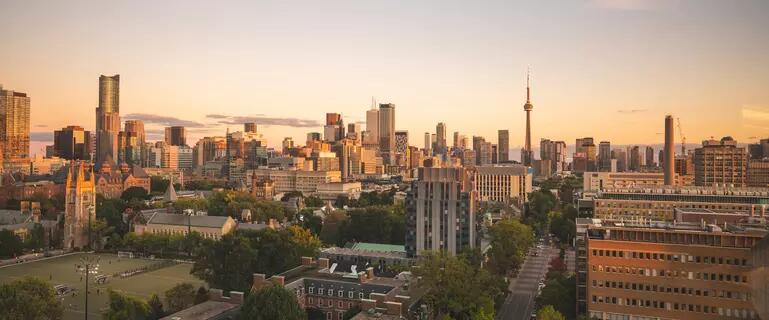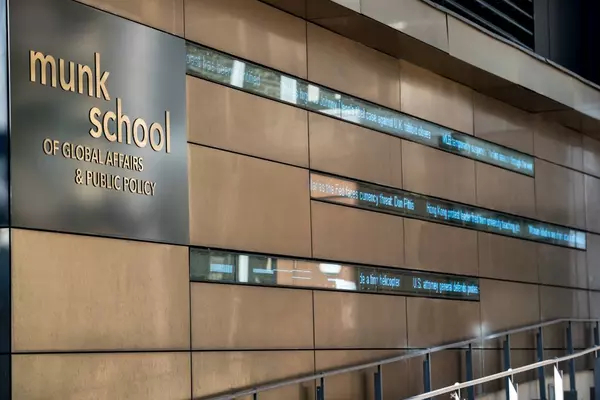Tom Kemeny is an associate professor at the Munk School of Global Affairs & Public Policy. His primary interests are in policy efforts and cities, particularly the determinants of economic prosperity and inequality.

Welcome to the Munk School — what drew you here in general?
Thank you. A combination of things drew me here. There is a huge amount of energy at the Munk School, and more widely at the University of Toronto, around the topics that I’m most interested in. For a long time, it has been on my radar as a place that is dynamic and produces remarkable work. Around 2018 or so, I was invited to give a research talk at the Munk School and I was impressed by what I saw — it feels like a really good place for me intellectually.
I’m also somebody who studies cities, so I have more than just a personal interest in them, but I think Toronto is a particularly vibrant place and in certain ways was the source of my initial love and intellectual interest in cities. I grew up in Toronto, but have not lived here in almost 20 years. It is wonderful to be back and I’m also curious to start observing how the city has transformed over the last 20 years.
Toronto has indeed seen quite drastic transformation. As someone who studies cities, what has stuck out to you as a critical area of change?
I should preface this by saying that I’ve only been back here a month and I’m still trying to get a feel for what the city has become.
Like many large cities in high income countries, there are common challenges like how to manage the affordability crisis, which is pronounced in Toronto and is similar to the cities that I study. Most of my work is focused on the United States and the United Kingdom, so I see many parallels in terms of the intracity challenges of where people are able to live and work.
More generally though, what defines a successful city is its provision of high-quality jobs that generate relatively high incomes and opportunity. I think that is a challenge that cities all over the world face, but certainly cities in high income countries in which the basis for success is going to be largely around the production of economically important ideas. Toronto certainly fits this pattern. Fundamentally, Toronto’s ability to be a vibrant city that can offer opportunity and high-quality jobs is going to be importantly premised on its ability to produce and reap the benefits of these ideas.
What has shaped your view of economic development and innovation? How would you define those concepts?
By innovation, I mean the production of ideas that have coherent economic value that can be exploited. The reason why innovation is so important is that it has allowed humanity to escape thousands, if not hundreds of thousands of years of stagnation. If you look at a graph of the expansion of gross domestic product in the world, and better still, gross domestic product per person, as far back as we can trace it from Year 0 to the early part of the nineteenth century, the line is flat. In other words, we are not for any reasonable length of time able to sustain producing more stuff, and certainly, when we are able to produce more stuff, it historically has led to too much population growth, too many mouths to feed and then another crisis.
The Industrial Revolution was premised on innovation in combination with fortuitous institutional arrangements that incentivized people to take risks and be entrepreneurial. As these ideas spread, there has been a massive upward trend in terms of humanity’s ability to produce value per person. We can think of this as productivity: a certain amount of human effort yields a particular output — and that output has grown dramatically as a function of innovation.
It is clear that innovation is hugely important in that, although our lives and humanity in the year 2022 is far from perfect, it seems to me at least very hard to argue that our lives are not dramatically better than they were in the age in which we were trapped in what seemed like an endless cycle of a little bit of growth, too much population growth and then large-scale starvation. At the core of that is innovation giving rise to productivity gains.
It seems like those would inherently be very positive — economic value and innovation — but it appears there are a lot more consequences hiding under the surface. Can you talk about what kind of consequences come with innovation and added economic value?
An obvious one is environmental consequences. Although the Industrial Revolution and its subsequent transformations have yielded self-evident dramatic gains in terms of life expectancy, general health and the average human’s level of comfort in the world, it has also generated unintended environmental consequences that we are in the midst of dealing with — with mixed success. This is obviously an enormous issue.
My research focuses on another important consequence: inequality. Much of my work these days is focused the fact that, while the last 200 years of human history track an unprecedented explosion of prosperity, the benefits have not been evenly spread. 250 odd years ago, depending on how we think about inequality, the average person was similar in income to most other people in the sense that most were desperately poor — low inequality.
Since around 1980, we have seen a particular kind of economic inequality in which the earnings of university-educated people have pulled away from the middle class and there was a stagnation of the middle class. Now in the last 20 years or so, that dynamic has become more complex, meaning there has also been a real expansion of inequality within educational and occupational groups.
Some of the work that I’m doing now tries to make sense of this pattern of inequality. Why are we living through an age of growing inequality? We can say that individual workers with particular kinds of educational qualifications or who perform certain tasks have benefited from innovation, but less explored and a focus of my recent work is trying to understand the geographical angle — the ways in which the economic performance of cities like New York, Los Angeles and San Francisco have, since around 1980, pulled sharply away from the rest of the U.S. economy.
To ignore the spatial dimension, to just focus on individuals within some abstract national economy, would be a mistake. We should care about spatial inequality because high-earners are geographically concentrated, because recent research tells us that place-based disparities shape differences in terms of opportunity and a whole range of outcomes such as health, social mobility and race-based exclusion. These aren’t just individual-level outcomes; they also have a place-based character. As the New Yorks, LAs and San Franciscos pull away from the rest of the economy, there is a geographic split between places that are able to offer job opportunities, health, economic rewards and places that are much less able to do so.
Do you see any ways of closing that gap to make things a little bit easier for the people who are the most directly affected? Do you see any tangible solutions to this wide chasm?
My focus right now is more on trying to understand what has happened and why. Before we can solve problems, we need to understand their causes. And it turns out the causes are not well agreed upon.
In terms of solutions though, in the United States, there is a growing debate about the role of policy in spurring place-based opportunity. This hasn’t always been a part of the conversation, in the sense that, among mainstream economists at least, the attitude used to be, “Well, let’s just let people move from the poor, struggling places to the places where opportunity is being offered.” I think this is a limited view of how we can address these kinds of problems, and that’s because my diagnosis of what is happening in these Superstar cities is not so much focused on individuals and their choices on where to live, but more so on deep structural forces that are inherent to capitalism. Unfortunately, that makes it so much harder to solve.
There are deeper roadblocks at work that if we’re going to be serious about policy, we need to be thinking about how we can better equip people in lagging places for success in a Superstar kind of economy. Making housing more affordable in Superstars is simply not enough.
How else can we better equip people?
We need to think more about place-based approaches, so I am glad that this is starting to re-emerge in policy debates. I don’t believe we can solve this by only thinking about people — we also need to think about ways to make cities better places to live in terms of the economic opportunity they offer. People do not move based purely on economic rationale. It makes sense to me to try and think about how we can make places more vibrant, because many cannot and do not want to move.
Now, that is a deeply challenging idea, and to be honest, we don’t know very well how to turn struggling places into vibrant, opportunity-rich places. And there are sobering lessons we can learn from Europe. The European Union has tried really hard over decades to make struggling places more vibrant and better places to live. And they have succeeded in many ways. Lagging places are tidy, have good infrastructure and so on. But, say you are a young and ambitious French woman. You are still going to feel the pull of Paris, and to a lesser extent Lyon — metropolitan cores that have concentrated, skilled, creative and high value work in just the same way we see it being concentrated in places like New York, Los Angeles, Toronto and London. Lagging places in Europe remain peripheral from the best economic opportunities so if you want those opportunities, you need to leave these lagging places.
What I take from this narrative is that even in countries that have spent a lot of money over several decades on place-based development, we still see these pronounced gaps between the large and dynamic core cities and the rest. We really don’t have the answers on the policy front. Of course, that doesn’t mean we shouldn’t try or think creatively about how we might do better, but we need to be cautious, and certainly mindful about international and historical lessons.
It’s certainly a large problem that requires a lot of solution-oriented thinking and big policy decisions. Maybe we’re just not equipped to make those at the moment if we’re still in the stages of getting into the nitty gritty of why these problems exist. What kind of impact has COVID-19 had on that, and what can we learn from the three-year crisis that has so largely impacted our cities in every conceivable way?
COVID-19 has provided a challenge for how we think about cities and it will take decades to unfold for us to see what happens.
What I mean by that is, for a long time, it was a central contention that one of the chief economic values of cities lay in our ability to be with one another, to serendipitously meet and exchange ideas. The standard answer in economic geography and urban economics is that people and firms bear the costs of this congestion and high prices because there is an economic return, and that economic return is largely in the form of information. That information flows in ways that makes it difficult to access at a distance. We get the same sort of narrative about the birth of Silicon Valley and certainly in its perpetuation: firms and workers bear extraordinarily high costs in these locations today because of the intangible, but nonetheless very important economic rewards that come from being close together. Cities here are imagined not as buildings and roads, but in terms of people in the absence of space.
COVID-19 and our approach to dealing with it has raised questions about the kinds of work for which repeated face-to-face contact is important and for which Zoom is not a replacement, versus work for which everyday togetherness is not so vital. There is a chunk of work that right now tends to be found in those same Superstar cities premised on open-ended problem solving and we are learning that this is simply not efficiently or effectively done at a distance. Lots of different kinds of work in different industries might fall into that category — when you’re trying to address a problem that isn’t well defined and needs to be mutually co-constructed with other people.
My reading is that there is a continuing logic to concentrating these jobs at the top of the urban hierarchy. This is high value work, which involves typically a long period of training and skill acquisition. So, to the extent that this kind of work is going to remain concentrated in those places and those workers doing that kind of work are going to have to commute in because that’s how you can get the work done — that suggests a kind of business as usual. At the same time, not all work currently in these cities fits this category. One might expect some changes in the structure of jobs and their geography — we do not know yet what this will mean.
Even in the biggest, most dynamic cities, I do think things may look different. We are not going to go back to the way that they used to be. On the other hand, I don’t think we are entering a world where we’re all going to be on our own private beach and there won’t be any more cities. I don’t buy that. That doesn’t seem plausible to me, although I’m no fortune teller.
The end of cities? As a city dweller, that sounds quite pessimistic.
When the interstate highways were built in the United States in the mid-20th century, that was also supposed to cause the end of cities because you could get anywhere you wanted quickly and so why would you live in city X when you could go build a house next to a meadow? The same prediction was made with the rise of the automobile early in the 20th century. There is a very long history of people saying, “well, this is going to cause the end of cities,” and so far, what has happened is that cities have become ever more central features of the global economy and our lives. That doesn’t mean it has to continue forever. But it should, at the minimum, allow us to read articles in the New York Times about the exodus of skilled workers from New York City with a bit of skepticism and caution.
With respect to the upcoming semester, what can be expected of you as a recent Munk School addition?
I will be teaching a Quantitative Methods course, which unlike some statistics courses, will be very applied and focused on how we can use statistics to answer questions and test ideas. The more substantive course that I’ll be teaching will be about a lot of the themes that we have been discussing— trying to understand the economy of cities, what makes some places more prosperous and dynamic than others, how we can think about geographical inequality and what to do about it.



